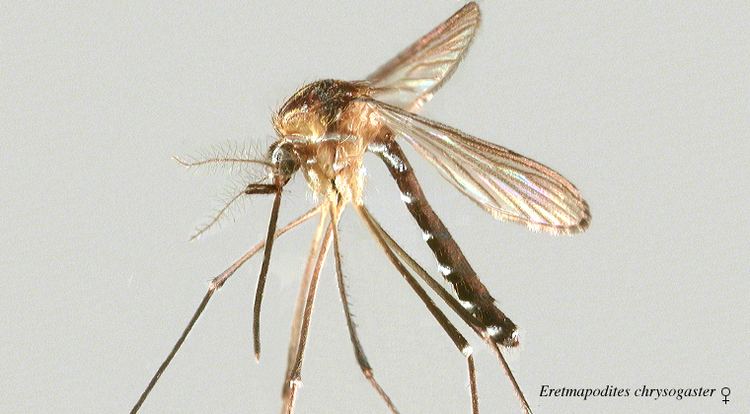Scientific name Eretmapodites Higher classification Mosquito Order Fly | Family Culicidae Rank Genus | |
 | ||
Similar Mosquito, Fly, Uranotaenia, Lutzia | ||
The Afrotropical mosquito genus Eretmapodites contains species that exhibit facultative cannibalism in their larval developmental stages. The species was first described in 1901 by Frederick Vincent Theobald. The type species is Eretmapodites quinquevittatus Theobald
Contents
Bionomics
Eretmapodites larvae feed primarily on decaying organic matter, but become cannibalistic when other food becomes scarce, and sometimes even in the presence of abundant other food material.
Larval breeding-places include small collections of water in larger fallen leaves, old tins and bottles, snail-shells, plant-axils, cut bamboo, and rarely tree-holes. Some species seem to breed exclusively in plant-axils; the majority are most frequently found in fallen leaves in forest habitat. They are strongly bottom-dwelling, so much so that when the water is poured out of a leaf containing them, most will remain on the surface of the leaf until washed off; larvae of species collected in Uganda and Sierra Leone have been observed crawling over the surface of the leaf.
When they become cannibalistic, they are predatory on other mosquito larvae, aquatic larvae of other small Diptera, and aquatic oligochaetes and nematodes. Smaller mosquito larvae are consumed whole, but larger ones have their internal contents sucked out, probably due to the difficulty of masticating the chitinous exoskeleton. Predatory larvae also attack pupae, seizing them by the tail and keeping them under water until they drown. Killed pupae are not eaten immediately, but left intact until partly decomposed and then eaten.
Predatory larvae have a thickened, comb-like modification of a group of the hairs on the medio-ventral aspect of the mouth-brushes resembling those found in the predatory species Lutzia tigripes. After seizing its prey, Eretmapodites larvae hold it between the half-flexed head and the ventral surface of the thorax and consume it rapidly, devouring a large larva in about 10 minutes.
Medical Importance
Eretmapodites species have been demonstrated to be laboratory vectors of yellow fever and chikungunya. Viruses isolated from wild-caught Eretmapodites include Rift Valley fever, Semliki forest, Spondweni, Nyando, Okola, Middleburg, Nkolbisson, and Bunyamwera viruses and an undefined viral agent, MTMP 131.
List of Species
Species listed by the Walter Reed Biosystematics Unit:
